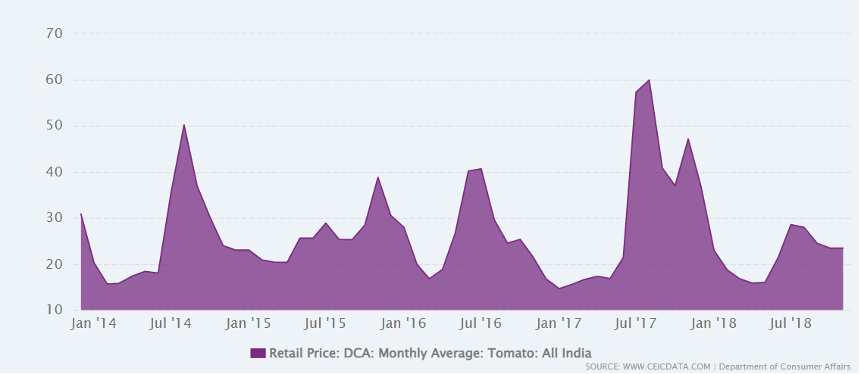Beating the Price Heat: Finding the Perfect Climatic Region for Affordable Tomato Cultivation in…
Beating the Price Heat: Finding the Perfect Climatic Region for Affordable Tomato Cultivation in Summer Months
Tomatoes are an essential crop in India, widely used in various culinary preparations. However, the prices of tomatoes often soar during the summer months due to a lack of supply. To address this issue, a study was conducted to identify districts in India that are ideal for tomato cultivation from April to July based on climate and soil conditions. This blog explores the significance of tomato cultivation, the challenges faced, and the opportunities for farmers to cultivate tomatoes in these regions.

The Tomato Price Conundrum: Despite India’s annual production of approximately 200,000 metric tonnes of tomatoes, there are periods when tomato prices skyrocket. Historical data reveals that prices particularly surge in June and July. In June 2022, retail prices reached up to Rs 100 per kilogram, causing financial strain for consumers and posing inflation challenges for the government.

Factors Affecting Tomato Prices: The major contributors to the price hikes are climatic variations, including high temperatures in May and June, as well as heavy rainfall. These factors affect tomato yields and disrupt the supply chain, resulting in an inadequate tomato supply during the summer months.
Identifying Optimal Cultivation Regions: To mitigate these challenges, a comprehensive study was conducted to identify districts suitable for tomato cultivation from April to June, ensuring a steady supply and price control. Ten districts were identified based on their favorable climate, including temperature, humidity, and rainfall, along with suitable soil conditions. These districts are Ahmadnagar and Aurangabad in Maharashtra, Amreli and Panch Mahals in Gujarat, Bhojpur in Bihar, Chandauli in Uttar Pradesh, Firozpur and Hoshiarpur in Punjab, Hanumangarh in Rajasthan, and Jharsuguda in Odisha.
The Ideal Climate and Soil Conditions: Tomato plants thrive in temperatures ranging from 21 to 24°C, while temperatures above 32°C negatively impact fruit development. Frost and high humidity are also detrimental to tomato plants. Additionally, tomatoes require low to medium rainfall for optimal growth. The selected districts have an average temperature range of 27 to 33°C during the critical growth period and exhibit low to medium rainfall. The humidity ranges from 35% to 65% in these districts.
Benefits and Challenges: Choosing these districts for tomato cultivation during the summer season offers several advantages. It helps stabilize tomato prices, benefiting consumers, while also providing profitable opportunities for farmers. Increased demand during the summer months ensures better prices for tomatoes, potentially improving farmers’ income. Additionally, tomato cultivation in these districts creates employment opportunities in post-harvest operations and the agricultural supply chain. Furthermore, it contributes to enhanced food security in these regions.
However, there are challenges associated with developing these regions for tomato cultivation. Infrastructure development for post-harvest handling and logistics is crucial. Government support and policies, including subsidies for technologies such as drip irrigation and mulching, are necessary to encourage farmers in these areas.
Conclusion: Tomato cultivation plays a vital role in India’s agricultural landscape and economy. Identifying specific districts for tomato cultivation from April to July helps ensure a stable supply and controls price fluctuations. It is imperative for the government to provide incentives to farmers in these districts to enhance tomato production and promote cultivation across the country. Similar studies can be conducted for other crops, providing valuable recommendations to stakeholders in the agricultural sector.
References:
- https://www.ceicdata.com/en/india/retail-price-department-of-consumer-affairs- agriculture-commodities-monthly-average-by-cities-tomato/retail-price-dca-monthly- average-tomato-all-india
- https://economictimes.indiatimes.com/news/economy/agriculture/tomato-prices-drop- by-60-in-a-month/articleshow/92860513.cms
- https://www.punekarnews.in/rising-tomato-prices-will-give-relief-in-two-weeks- know-why-prices-are-increasing/
- India Meteorological Department
- Fyllo (www.fyllo.in)
- Indian Institute of Social Science ( https://iiss.icar.gov.in//Maps/ )
- Crop suitability and agricultural data: National Remote Sensing Centre (NRSC), Indian Institute of Horticulture Research (https://www.iihr.res.in/improved-production- technology-tomato-crop)
- Agricultural commodity price data: Ministry of Agriculture and Farmers’ Welfare, National Horticulture Board.
